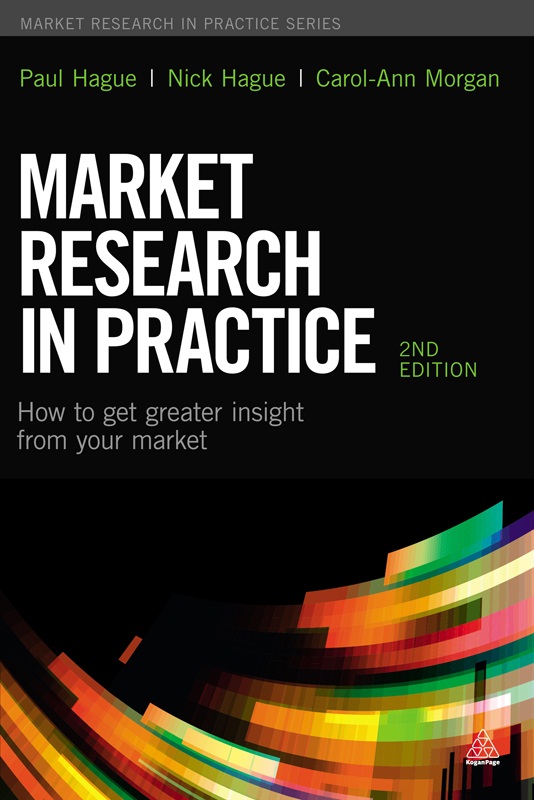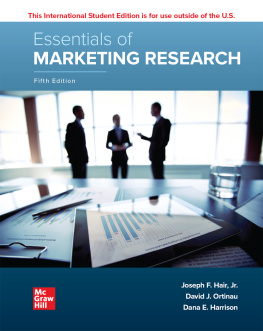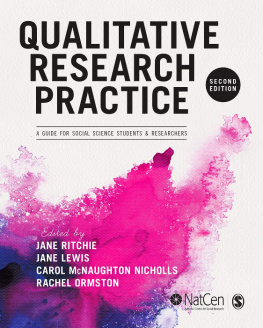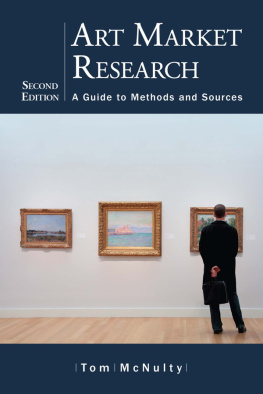

Note on the Ebook Edition
For an optimal reading experience, please view large
tables and figures in landscape mode. |
This ebook published in 2013 by
Kogan Page Limited
120 Pentonville Road
London N1 9JN
UK
www.koganpage.com
Paul Hague, Nick Hague and Carol-Ann Morgan, 2013
E-ISBN 978 0 7494 6865 1
Dedication
This book is dedicated to Casper, Daisy, Lily and Oliver.
N o one at school ever says they want to be a market researcher. It is a job that most people fall into by accident and yet it is arguably one of the best jobs in the world. Where else could someone with a curious mind be paid to find out what is going on? Nowhere else could there be such a variety of work: exploring motivations, finding out what is going on and always seeking the truth.
The three of us just fell into the job and it has kept our interest for years. In fact between us we have 70 years experience in the profession to share with you. And theres another thing: this often intellectually challenging job doesnt have quite the status of other professions. We market researchers are an aspiring lot, always seeking to be analysts, consultants and advisors rather than authors of yet just another horizontal bar chart.
We would be less than honest with ourselves if we didnt confess that sometimes we find the life of a market researcher difficult. We are increasingly asked to jump over Olympian-high hurdles in the search for some new piece of intelligence that will give our clients a commercial advantage. Perhaps this is what keeps us interested, seeking the Holy Grail and occasionally getting quite close to it.
This book is an introduction to market research. It seeks to give the reader a taste of the whole process from planning a project and executing it, through to analysis and presenting the findings. It is aimed at students who need to understand the theory of the subject as well as people who want to carry out or manage their own surveys. Essentially it is a practical book, hence its title, and it is written by practitioners as this is what we do for our day job. Our aim is to educate you, of course, but also to enthuse you in this most wonderful subject, which we guarantee will absorb, frustrate and mainly satisfy you as your skills are developed.
In order to enliven the subject, the book is laced with examples of studies we have carried out over the last 40 years. This brings us to our first acknowledgement. Between us we have worked on a few thousand projects, each one paid for by a client. A typical project costs an amount equal in value to a new medium-sized saloon car. Commissioning market research is like buying a pig in a poke the quality of the job is only evident when it is complete. We are ever grateful for these commissions. They are a supreme vote of confidence. They provide a livelihood. Not least they have enabled us to learn our craft.
One thing has remained the same over the years and that is the axiom: good market research is about asking the right question of the right person. In order to do this we need a field force. Market research interviewers use our questionnaires day in and day out. Sometimes (no, often) these questionnaires are less than perfect but the interviewers make them work for us. These people are not in the spotlight. When we present the findings and bathe in the glory of a successful conclusion (hopefully), these stalwarts have moved on and their heads are down on the next survey. The data-processing staff, whose timetable was squeezed because the project was running late, do not have time to draw breath as they too are working on their next screamingly urgent deadline. These support staff are the unsung heroines and heroes of market research, and we salute them.
Market research is almost always a team effort. Most projects involve a small battalion of people. Indeed, this book is an example of team work. For a start, we are three authors actually four because we should not forget Peter Jackson who contributed many sections from earlier books and epistles he wrote with Paul. We must also thank our editor, Nicola de Jong of Kogan Page, for her encouragement and expertise in keeping the timetable on track.
However, the real help as always comes from our patient families who have to suffer parents and partners who seldom come home early. Ray, Andrew and Chris thank you for waiting for us.
Finally, our greatest debt goes to you, the reader, without whom there would be no market for our scribblings. Our hope is that we stimulate you to want to learn more about this fascinating, frustrating and most rewarding subject that occupies our life.
CONTENTS
For online resources to accompany this book, visit: www.koganpage.com/MRinPractice |
You are walking through a farmers market where the stalls are full of plump produce. The stallholders have their wares positioned so that they are displayed to best advantage. Some are shouting to catch your attention. There are price tickets clearly displaying the cost of each item. It is busy and very noisy. Business is brisk and sellers and buyers seem to be in perfect harmony each understands the other. It is highly unlikely that any of the stallholders have ever read a market research textbook, designed a questionnaire or carried out a survey; but they certainly do carry out market research.
Customers comment on the produce and the stallholders listen and respond, adjusting the next days or weeks stock. Each looks at the others prices and knows instantly if they are out of line. And if they are, a quick adjustment is made. The stallholders watch and listen to each other to see how effective they are at catching the attention of the crowd, and if someone has a good idea, others quickly copy it. The stallholders antennae are constantly monitoring the market because if they were not, they would soon be out of business.
You are whisked off now to the offices of a global company in Philadelphia. The company has plants in 30 different countries and it employs 30,000 people. It sells through 300 distributors who in turn sell to hundreds of thousands of customers. How does the boss of this company stay in tune with its market?
First, he or she has internal sources. Managers of each territory make their reports. The functional heads compile data on sales, finance and production. And whenever time allows, the boss does his/her own tour. But the position is no way as clear as it is to the stallholder. There are conflicting views from staff. Cultural differences around the world blur the understanding. Customers are distanced by distributors and there are few opportunities for them to express their opinion. What is more, unlike the stallholder who can quickly make adjustments to changing conditions, it takes an army of people weeks and months to make changes in the global company. The cost of a wrong decision is a fall in sales and profitability, resulting in the loss of thousands of jobs and millions of dollars off the share price. This company cannot rely on its antennae to tell it what is going on, it needs a process.
Market researchers have a tool kit made up of desk research, telephone interviews, face-to-face interviews, self-completion questionnaires, focus groups and observation. They employ special techniques for selecting samples and analysing the data. Much of this book is devoted to these subjects, explaining how each works and how to do your own market research. However, it is equally important to understand what market research is for why it is carried out. It is helpful, therefore, before we get into the tool kit, to consider the role of market research in decision making as this provides a context for the later discussions of methods and techniques.















